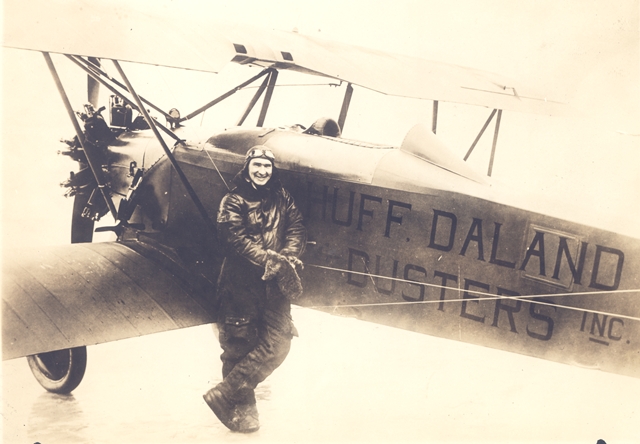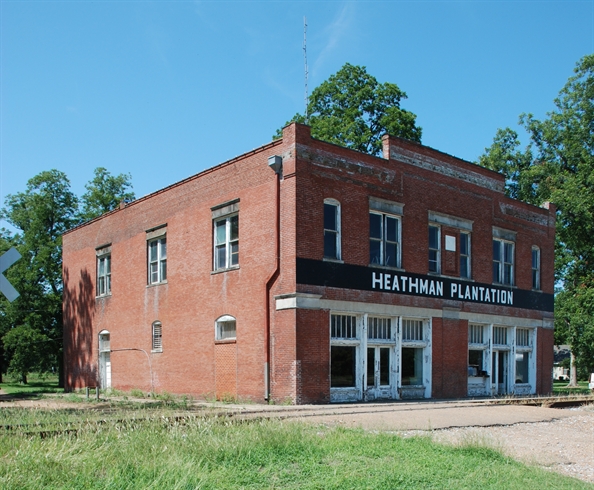Today is the last featured entry of our series based on the Mississippi entries from the 1976 document A Nation in Motion: Historic American Transportation Sites. If you are just joining us the background is that an informal compilation of nationally important transportation sites sprang from a 1973 suggestion by the Advisory Council on Historic Preservation to the United States Department of Transportation. Its purpose was not to be a definitive listing of significant transportation sites, but rather a collection of information on transportation-related sights that might be considered for inclusion on the National Register of Historic Places. There were a total of five separate entries for Mississippi. We’re looking at each item to see what their status is today. This may give us some insight as to how effective this type of document is.

Huff-Daland duster with pilot Harris 1920s from http://www.deltamuseum.org Accessed 7-7-2014
Mississippi 1924: The Robertshaw Company Plantation at Heathman, between Leland and Indianola was the site on September 1924 of the fist commercial airplane crop dusting for insect control in the United States. Huff-Deland Company of Ognesburg, N.Y. manufactured a specially-designed airplane equipped for cotton dusting in accordance with specifications developed by the Tullulah, La., Laboratory of the Bureau of Entomology. Robertshaw contracted for the dusting of 1,800 acres by Huff-Deland at 35 cents per acre. Since that time aerial application of insecticides has become a major aspect of general aviation and significant factor in agricultural production.
Outcome: With 18 planes, Huff-Daland Airplanes, Inc. was the world’s largest privately owned fleet of aircraft in 1924. The company would start a passenger service in 1929 whose name you might recognize: Delta Air Lines. The Huff-Daland Duster Petrel 31 planes were build specifically for the task of dusting after initial dusting tests were carried out with Curtis-JN 4’s (similar to the planes we read about in the last NIM post.) While there had been many previous crop dusting experiments that had been carried out, this flight was the first purely commercial venture of crop dusting.
Thanks to its caring owner the Commissary, Seed House and Bell of Heathman Plantation were listed on the National Register of Historic Places on September 20, 2012. I’m doubtful this listing was spurred on by the 1976 Nation in Motion inclusion. The only other item of note is that the NIM entry misspells “Huff-Daland.” I recently ran across an original draft of the Nation In Motion document. It had one correct spelling and one incorrect spelling, but was edited to the incorrect spelling. [This find of the draft document does have some interesting differences from the published version and gives an opportunity to extend this series by looking at some entries that were cut or conversely some that were not originally included.]
I’m not sure if or how the crop-dusted area would be included on the National Register. There are NR sites much larger than 1800 acres but does the first commercial crop dusting warrant the need for such a large site? Or is it not appropriate to list only part of the original area dusted? How does this change if portions of that land are no longer in agricultural use? Malvaney has discussed difficulties in the past when it comes to rural NR Nominations. The 2012 NR nomination does not mention the 1924 dusting, but to be fair the dusting may have nothing to do with the buildings in the five-acre area listed. Would the inclusion of the 1924 dusting have changed the building’s significance from its current Local significance listing to a National significance listing? Maybe someone with a broader knowledge of the National Register can enlighten us?
Current status: Suzassippi first brought Heathman Plantation onto my radar with a July 2012 post. The nomination states that the buildings Current Functions are a “work in progress.” With the NR listing the owner might be eligible for state and federal tax credits to fund the work. On a side note, one of the original eighteen Huff-Daland dusters is part of the Smithsonian National Air and Space Museum’s collection, which includes the Key Brothers “Ole Miss”. The Huff-Daland is on display at the Boeing Aviation Hangar at the Steven F. Udvar-Hazy Center in Chantilly, VA.
This is the fifth of the series reviewing the Mississippi entries in the Department of Transportation’s A Nation in Motion: Historic American Transportation Sites. To see all the posts in the series click here.
Categories: Books, Delta, Historic Landscapes, Historic Preservation, Indianola, National Register, Urban/Rural Issues


I enjoyed reading this article about the company that became Delta Air Lines (not Airlines, as most such companies are called).
LikeLike
I am glad you enjoyed the post. The Delta Air Lines aspect almost seems a foot note to this story (a foot attached to a very large body.)
LikeLike
We all owe Lois Pillow Robertson a big round of applause for taking care of this grand building. It is far and away the largest commissary/plantation office in the Delta and even had a hospital upstairs. Something good seems to be developing out there. Bravo for the Robertsons.
LikeLike
Hear-Hear. I was thinking this morning about how paramount an owners to a building survival. All the money, time, and public support dont mean a thing without an owner whose willing to take care and do what is best for a building.
LikeLike
Great story!
LikeLike
Thank you! I would have had no idea about this place had you not shared with us first :)
LikeLike
Just an accidental find taking the back roads to Texas. :) I discovered a whole of stuff doing that!
LikeLike